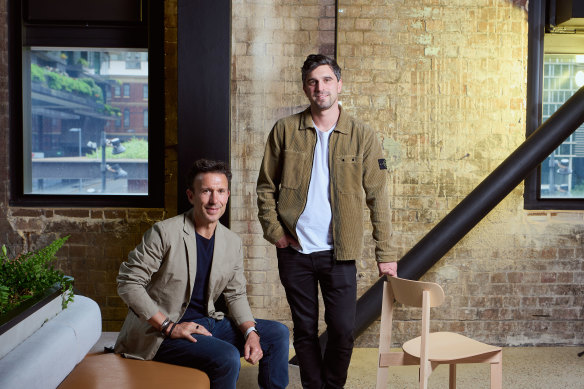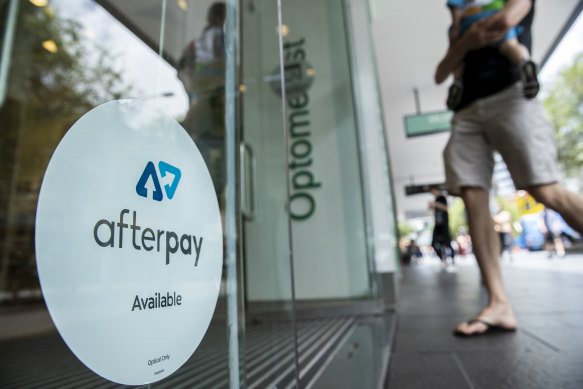This was published 8 months ago
Afterpay billionaires say Australia is well on its way to a cashless future
Afterpay became a multibillion-dollar business partly by detecting and responding to major shifts in financial behaviour. So, co-founders Nick Molnar and Anthony Eisen’s views on payment trends carry a certain amount of weight.
The payments juggernaut has for years been betting that consumers want alternatives to high-interest credit cards, and it’s a prediction that has largely proven accurate, as younger generations have proven more debt-shy than predecessors.

Afterpay co-founders Anthony Eisen (left) and Nick Molnar say that going cashless appears to be a question of when, not if.Credit: Flavio Brancaleone
But what about the other massive shift in how Australians are paying for things - the decline of cash? When might we move away from physical currency altogether?
In an interview this week, Molnar pointed out Australia is further down the path of going cashless than most places. “I think Australia’s is further along into the next phase of the cashless economy than most regions,” he said.
Eisen agreed, adding that going cashless appears to be a question of when, not if: “I think with everything that we’ve been seeing for the last five years, it’s not really even a question. It’s just, what’s the time frame?”
The comments underline the ongoing changes in payments, and they come as Afterpay this week marked 10 years since it launched, by pointing to what it called a “generational shift” away from credit cards. In another major milestone for the company, Eisen last week said he would step away from executive duties to focus on other pursuits, including philanthropy.
Afterpay - which provides “buy now, pay later” (BNPL) loans that are repaid in four interest-free, fortnightly instalments - emerged at a time of massive change in how consumers pay for things.
Cash use has fallen off a cliff, while digital payments on smartphones have boomed, as have the BNPL loans offered by Afterpay and rivals, prompting the government to move to regulate the sector. Another striking change has been the rise of debit cards: Reserve Bank figures show debit cards made up more than half of all payments in 2022, up from just 15 per cent in 2007.
These trends have all played a role in Afterpay’s journey from a start-up to the target of a 2021 takeover from US fintech Block, which valued the company at $39 billion at the time.
Roughly three years after the takeover, Molnar says it still feels “early in our innings,” and he thinks the company is just at the start of its plans to disrupt banking.

Afterpay has come a long way in 10 years.Credit: Louie Douvis
He predicts debit cards will continue to play a bigger role in overall spending, as debt-adverse Generation Z customers grow older and earn more income, and as this happens, the company is focused on how it can “diversify” its relationships with these customers.
While it previously worked on doing this via a banking app with Westpac, this plan was dumped after the deal with Block - which owns payments business Square, and a peer-to-peer payments app called Cash App. Molnar, who reports to Block boss Jack Dorsey, says further work on how these platforms work together is a key priority.
“I think we’re in a unique position as it relates to having Square and Afterpay - two really strong brands in the local market - and how we think about gaining leverage across the ecosystem. And that’s really where Block is focused,” he says.
‘I think Australia’s is further along into the next phase of the cashless economy than most regions.’
Afterpay co-founder Nick Molnar
It’s been a rapid ascent for a company that started in Sydney’s eastern suburbs when Molnar and Eisen, who were neighbours, founded the business together. Molnar and Eisen are now billionaires, according to the Australian Financial Review’s Rich List, and the company recently opened a flash new office in what used to be a brewery in Sydney’s Chippendale. In contrast, Eisen recalls about nine years ago its office was a “tiny little room” in Surry Hills without internet, so everyone tethered to their phone.
While Eisen is stepping down from being an executive at Block, he will remain on Afterpay’s Australian board, he is on the Tech Council of Australia’s board and wants to pursue philanthropic interests. “I think I’d annoy my family too much if I didn’t keep being involved in business or different enterprises or different things, but philanthropy is a privilege and it will be a focus for me and my family for a little while,” he says.
Meanwhile, the market has been warming to BNPL firms - a polarising sector that suffered a dramatic valuation implosion when interest rates rose in 2022.
Block shares, which are dual listed, are up 50 per cent in the past year, and shares in Afterpay’s main Australian rival Zip have surged more than 600 per cent over that period. Block on Friday said spending on Afterpay’s BNPL platform had risen 23 per cent year-on-year to US$8.24 billion in the latest quarter. Its shares were down 6 per cent in early trading after the quarterly update.
While some question the industry’s long-term prospects competing with banks, long-time backer and Block shareholder ECP Asset Management says outstanding credit card debt in Australia is worth more than $40 billion and more than US$1 trillion in the US. It argues this means there is plenty of room for growth in “modern consumer credit models”.
The Market Recap newsletter is a wrap of the day’s trading. Get it each weekday afternoon.